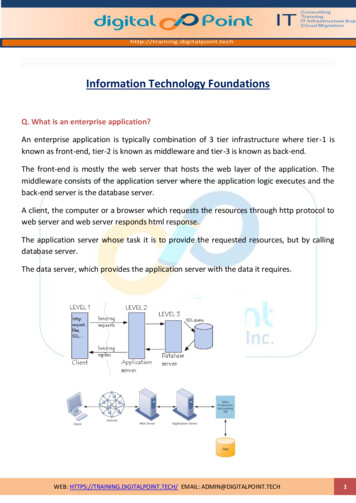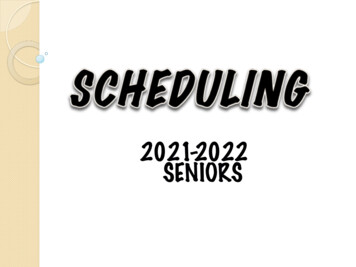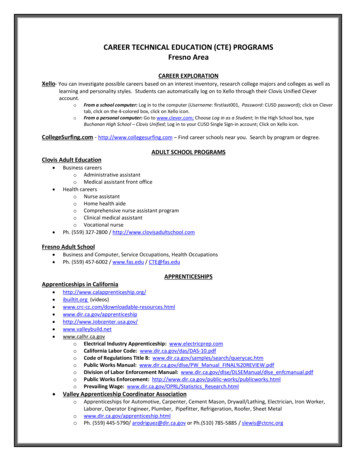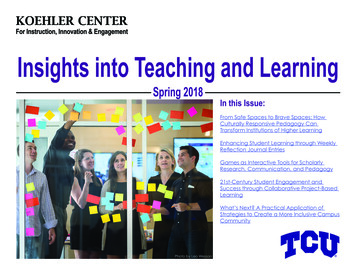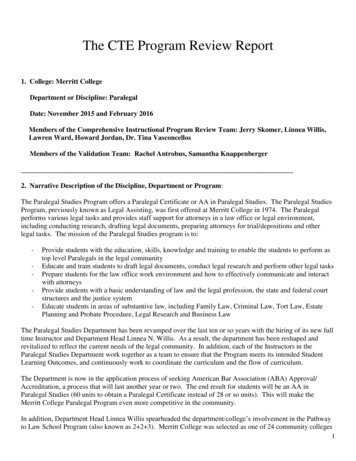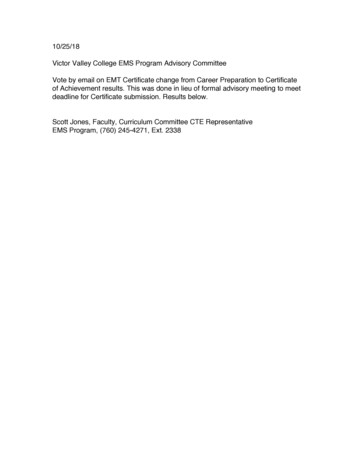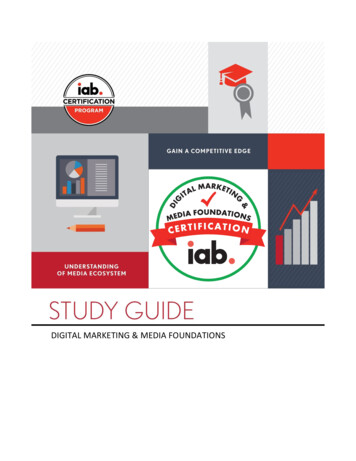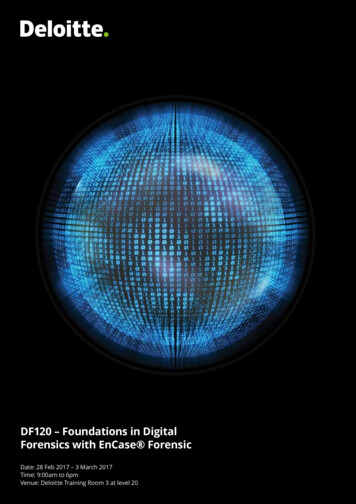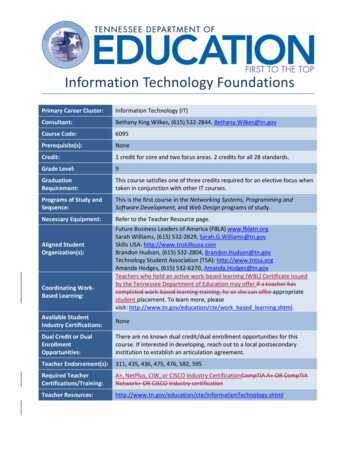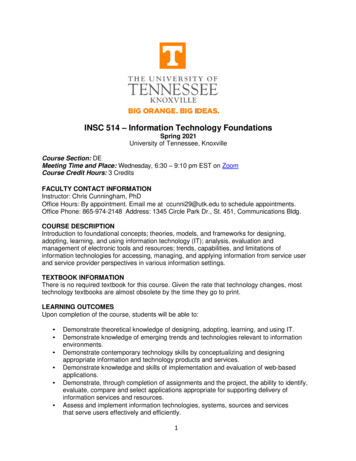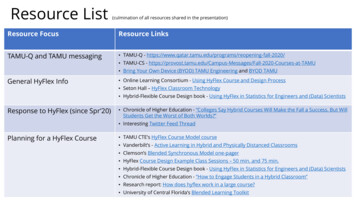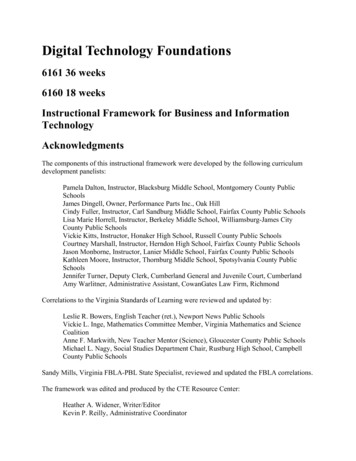
Transcription
Digital Technology Foundations6161 36 weeks6160 18 weeksInstructional Framework for Business and InformationTechnologyAcknowledgmentsThe components of this instructional framework were developed by the following curriculumdevelopment panelists:Pamela Dalton, Instructor, Blacksburg Middle School, Montgomery County PublicSchoolsJames Dingell, Owner, Performance Parts Inc., Oak HillCindy Fuller, Instructor, Carl Sandburg Middle School, Fairfax County Public SchoolsLisa Marie Horrell, Instructor, Berkeley Middle School, Williamsburg-James CityCounty Public SchoolsVickie Kitts, Instructor, Honaker High School, Russell County Public SchoolsCourtney Marshall, Instructor, Herndon High School, Fairfax County Public SchoolsJason Monborne, Instructor, Lanier Middle School, Fairfax County Public SchoolsKathleen Moore, Instructor, Thornburg Middle School, Spotsylvania County PublicSchoolsJennifer Turner, Deputy Clerk, Cumberland General and Juvenile Court, CumberlandAmy Warlitner, Administrative Assistant, CowanGates Law Firm, RichmondCorrelations to the Virginia Standards of Learning were reviewed and updated by:Leslie R. Bowers, English Teacher (ret.), Newport News Public SchoolsVickie L. Inge, Mathematics Committee Member, Virginia Mathematics and ScienceCoalitionAnne F. Markwith, New Teacher Mentor (Science), Gloucester County Public SchoolsMichael L. Nagy, Social Studies Department Chair, Rustburg High School, CampbellCounty Public SchoolsSandy Mills, Virginia FBLA-PBL State Specialist, reviewed and updated the FBLA correlations.The framework was edited and produced by the CTE Resource Center:Heather A. Widener, Writer/EditorKevin P. Reilly, Administrative Coordinator
Virginia Department of Education StaffJudith P. Sams, Specialist, Business and Information Technology and Related ClustersDr. Tricia S. Jacobs, CTE Coordinator of Curriculum and InstructionDr. David S. Eshelman, Director, Workforce Development and InitiativesGeorge R. Willcox, Director, Operations and AccountabilityOffice of Career, Technical, and Adult EducationVirginia Department of EducationCopyright 2019Course DescriptionSuggested Grade Level: 8 or 6 or 7Prerequisites:This foundation course introduces the use of relevant and emerging technologies, tools, andapplications to prepare students for current workplace practices and everyday life. Students willdemonstrate information processing using a variety of hardware and software and Internet-basedtools to produce and integrate data in various formats. This course is designed for studentswishing to progress through more advanced business and information technology coursework.Recommended prerequisite(s): Keyboarding course(s) or teacher-approved demonstration oftouch keyboarding skills.2
Task/Competency ListTemplate material omitted: General material used to introduce the task list has been omitted.For the indicated course(s): Tasks/competencies designated by plus icons ( ) in the left-hand column(s) are essentialTasks/competencies designated by empty-circle icons ( ) are optionalTasks/competencies designated by minus icons ( ) are omittedTasks marked with an asterisk (*) are sensitive.TaskNumber6161 6160Tasks/CompetenciesExploring the Digital Input Technologies Mix001Apply ergonomic guidelines for safe computer use.002Identify ergonomic hazards in the workplace.003Key alphabetic, numeric, and symbolic information, using a touchsystem.004Use keyboarding techniques to improve typing speed andaccuracy.005Research developments in relevant and emerging technologies.006Identify technologies, tools, and applications and their uses forlifelong learning.007Explain the functions of computing systems.008Demonstrate booting, accessing, and exiting an OS andapplications.Practicing Digital Skills009Manipulate data, software, and OS.010Use file-management techniques to manipulate and organizefolders and files.011Edit copy.012Collaborate using web-based resources.3
013Format documents.014Format tables, graphs, and charts.015Create a spreadsheet.016Format addresses on labels and envelopes.017Incorporate graphic elements in documents.018Create a multimedia presentation.019Troubleshoot computer input/output problems.020Use verbal-input applications.Using Digital Tools and Resources021Digitize content.022Identify the components and functions of a digital input device.023Create digital images.024Create digital art.025Create a video.026Insert video into an application.027Create audio narrations or voice-overs.Exploring Mobile Devices, Cloud Computing, and the Internet of Things (IoT)028Use applications on standard mobile devices.029Explain cloud computing.030Research developments in cloud computing.031Save data to the cloud, so it will be accessible from a personalcomputer (PC), file-hosting service, smartphone, and otherdevices.032Research developments in IoT.Applying Digital Literacy Skills4
033Explain principles of digital citizenship.034Use search strategies on the Internet.035Navigate the Internet.036Manage an online account.Preparing for a Career037Research the use of digital technology in careers within the sixteencareer clusters.038Identify personal interests, aptitudes, and attitudes found insuccessful students and professionals.039Develop a career plan.040Identify the importance of social media in the job-acquisitionprocess.041Develop a digital portfolio.042Legend:EssentialIdentify potential employment barriers for nontraditional groupsand ways to overcome the barriers.Non-essential OmittedExploring the Digital Input Technologies MixTask Number 001Apply ergonomic guidelines for safe computer use.DefinitionApplication should include demonstrating the positioning of the body for the hardware being usedpositioning the body according to the type of desk being used, including standing desksand adjustable desks5
positioning the keyboard directly in front of a chair, even with the front edge of the deskand at elbow height so wrist movement is not restrictedadjusting visual components (e.g., placing the monitor 18 to 24 inches from the eyes,with the top edge of the display screen at eye level)taking short breaks every hour to relax the neck, shoulders, arms, wrists, and fingersidentifying ergonomic guidelines for other devices (e.g., gaming, smartphones, tablets).FBLA Competitive Events and Activities AreasIntroduction to Computer Science & CodingMultimedia & Website DevelopmentTask Number 002Identify ergonomic hazards in the workplace.DefinitionIdentification should include defining workplace hazardgiving examples of hazards and the effects of failing to address them (e.g., repetitivestrain injury [RSI])identifying ways to prevent ergonomic hazardsexplaining the importance of workplace safety.Related Standards of LearningEnglish6.4The student will read and determine the meanings of unfamiliar words and phrases withinauthentic texts.a. Identify word origins and derivations.b. Use roots, affixes, synonyms, and antonyms to expand vocabulary.c. Use context and sentence structure to determine meanings and differentiateamong multiple meanings of words.d. Identify and analyze the construction and impact of figurative language.e. Use word-reference materials.f. Extend general and cross-curricular vocabulary through speaking, listening,reading, and writing.6
7.4The student will read and determine the meanings of unfamiliar words and phrases withinauthentic texts.a.b.c.d.e.Identify word origins and derivations.Use roots, affixes, synonyms, and antonyms to expand vocabulary.Identify and analyze the construction and impact of figurative language.Identify connotations.Use context and sentence structure to determine meanings and differentiateamong multiple meanings of words.f. Use word-reference materials to determine meanings and etymology.g. Extend general and cross-curricular vocabulary through speaking, listening,reading, and writing.8.4The student will apply knowledge of word origins, and figurative language to extend vocabularydevelopment within authentic texts.a. Identify and analyze the construction and impact of an author’s use offigurative language.b. Use context, structure, and connotations to determine meaning and differentiateamong multiple meanings of words and phrases.c. Use roots, affixes, synonyms, and antonyms to determine the meaning(s) ofunfamiliar words and technical vocabulary.d. Identify the meaning of common idioms.e. Use word-reference materials to determine meanings and etymology.f. Discriminate between connotative and denotative meanings and interpret theconnotation.g. Extend general and cross-curricular vocabulary through speaking, listening,reading, and writing.FBLA Competitive Events and Activities AreasIntroduction to Computer Science & CodingMultimedia & Website DevelopmentTask Number 003Key alphabetic, numeric, and symbolic information, using atouch system.Definition7
Keying should include placing keyboard at the front edge of the deskkeeping eyes on the copy, not on the keyboard, even when reaching for another row orkey locationplanting feet on the floorpositioning wrists low but not touching the framecurving fingers and placing them upright on the home keysmaintaining correct, comfortable postureholding arms parallel with the pitch of the keyboard.FBLA Competitive Events and Activities AreasCommunity Service Project (Middle Level)Introduction to Computer Science & CodingMultimedia & Website DevelopmentTask Number 004Use keyboarding techniques to improve typing speed andaccuracy.DefinitionUse should include identifying techniques that may be problematic (i.e., bad habits)practicing technique drills to correct the problematic techniquespracticing drills that encourage speed and accuracyachieving a controlled rate of speed that promotes accuracyself-assessing progress.FBLA Competitive Events and Activities AreasCommunity Service Project (Middle Level)Introduction to Computer Science & CodingMultimedia & Website Development8
Task Number 005Research developments in relevant and emergingtechnologies.DefinitionResearch should include the use of periodicals, the Internet, and other sources to describerelevant and emerging technologies.Related Standards of LearningEnglish6.9The student will find, evaluate, and select appropriate resources to create a research product.a.b.c.d.e.Formulate and revise questions about a research topic.Collect and organize information from multiple sources.Evaluate and analyze the validity and credibility of sources.Cite primary and secondary sources.Avoid plagiarism by using own words and follow ethical and legal guidelinesfor gathering and using information.f. Demonstrate ethical use of the Internet.7.9The student will find, evaluate, and select appropriate resources to create a research product.a.b.c.d.Formulate and revise questions about a research topic.Collect, organize, and synthesize information from multiple sources.Analyze and evaluate the validity and credibility of resources.Quote, summarize, and paraphrase information from primary and secondarysources using proper citations.e. Avoid plagiarism by using own words and follow ethical and legal guidelinesfor gathering and using information.f. Demonstrate ethical use of the Internet.8.9The student will find, evaluate, select, and synthesize appropriate resources to produce a researchproduct.a. Formulate and revise questions about a research topic.b. Collect and synthesize information from multiple sources.9
c. Evaluate and analyze the validity and credibility of resources.d. Analyze information gathered from diverse sources by identifyingmisconceptions, main and supporting ideas, conflicting information, point ofview, or bias.e. Cite primary and secondary sources using Modern Language Association(MLA) or American Psychological Association (APA) style.f. Quote, summarize and paraphrase research findings.g. Publish findings and respond to feedback.h. Avoid plagiarism by using own words and follow ethical and legal guidelinesfor gathering and using information.i. Demonstrate ethical use of the Internet.History and Social ScienceWG.17The student will apply social science skills to analyze the impact of globalization bya. identifying factors, including comparative advantage, that influence thedistribution of economic activities and trade;b. describing ways that economic and social interactions change over time; andc. mapping, describing, and evaluating economic unions.FBLA Competitive Events and Activities AreasCareer ExplorationIntroduction to Computer Science & CodingMultimedia & Website DevelopmentTask Number 006Identify technologies, tools, and applications and their usesfor lifelong learning.DefinitionIdentification of each should include its usefulness in electronic note-taking, writing, and text inputscheduling and tracking of assignmentsmaintaining calendars and task lists10
researchingcommunicating and collaboratingmanaging and organizing data.FBLA Competitive Events and Activities AreasBusiness EtiquetteCareer ExplorationCommunity Service Project (Middle Level)Critical ThinkingDigital CitizenshipElevator SpeechIntroduction to Computer Science & CodingMultimedia & Website DevelopmentTask Number 007Explain the functions of computing systems.DefinitionExplanation should include examples of computing devices (e.g., gaming systems, mobiledevices) and operating systems (OS) and should include concepts such as input/output methodscentral processing unit (CPU)storage and retrieval of information (e.g., flash drives, internal and external hard drives,and cloud computing).Related Standards of LearningEnglish6.6The student will read and demonstrate comprehension of a variety of nonfiction texts.11
a. Skim materials using text features such as type, headings, and graphics topredict and categorize information.b. Identify main idea.c. Summarize supporting details.d. Create an objective summary including main idea and supporting details.e. Draw conclusions and make inferences based on explicit and impliedinformation.f. Identify the author’s organizational pattern(s).g. Identify transitional words and phrases that signal an author’s organizationalpattern.h. Differentiate between fact and opinion.i. Identify cause and effect relationships.j. Analyze ideas within and between selections providing textual evidence.k. Use reading strategies to monitor comprehension throughout the readingprocess.7.6The student will read and demonstrate comprehension of a variety of nonfiction texts.a. Skim materials using text features including type, headings, and graphics topredict and categorize information.b. Identify an author’s organizational pattern using textual clues, such astransitional words and phrases.c. Make inferences and draw logical conclusions using explicit and impliedtextual evidence.d. Differentiate between fact and opinion.e. Identify the source, viewpoint, and purpose of texts.f. Describe how word choice and language structure convey an author’sviewpoint.g. Identify the main idea.h. Summarize text identifying supporting details.i. Create an objective summary including main idea and supporting details.j. Identify cause and effect relationships.k. Organize and synthesize information for use in written and other formats.l. Analyze ideas within and between selections providing textual evidence.m. Use reading strategies to monitor comprehension throughout the readingprocess.8.6The student will read, comprehend, and analyze a variety of nonfiction texts.a. Identify an author’s organizational pattern using textual clues, such astransitional words and phrases.b. Apply knowledge of text features and organizational patterns to analyzeselections.c. Skim materials to develop an overview or locate information.12
d. Make inferences and draw conclusions based on explicit and impliedinformation using evidence from text as support.e. Analyze the author’s qualifications, viewpoint, word choice, and impact.f. Analyze details for relevance and accuracy.g. Differentiate between fact and opinion.h. Identify the main idea.i. Summarize the text identifying supporting details.j. Identify cause and effect relationships.k. Evaluate, organize, and synthesize information for use in written and otherformats.l. Analyze ideas within and between selections providing textual evidence.m. Use reading strategies to monitor comprehension throughout the readingprocess.FBLA Competitive Events and Activities AreasCareer ExplorationCritical ThinkingDigital CitizenshipElevator SpeechIntroduction to Computer Science & CodingMultimedia & Website DevelopmentTask Number 008Demonstrate booting, accessing, and exiting an OS andapplications.DefinitionDemonstration should include signing in and signing out of an OS and applicationsusing hardware and application controls to boot, access, and exit an OSselecting an icon or searching the OS to access applicationssaving, sharing, and retrieving workminimizing random-access memory (RAM) usageexiting applications.13
FBLA Competitive Events and Activities AreasCareer ExplorationCritical ThinkingDigital CitizenshipIntroduction to Computer Science & CodingMultimedia & Website DevelopmentPracticing Digital SkillsTask Number 009Manipulate data, software, and OS.DefinitionManipulation should include using function keys; keyboard, program, or desktop shortcuts; andmenu/tool bars for cutting/pasting and copying/pastingsaving dataopening and closing programsusing a pointing device to pull down menushovering to determine functionality.FBLA Competitive Events and Activities AreasCareer ExplorationCritical ThinkingDigital CitizenshipIntroduction to Computer Science & Coding14
Multimedia & Website DevelopmentTask Number 010Use file-management techniques to manipulate and organizefolders and files.DefinitionUse should include creating or deletingnaming or renamingopening or closinguploading or downloadingmovingcopyingsharing (including setting permissions and protecting privacy)savingusing passwords to protect documents and filesclosingfolders and files as well as addressing formats and compatibilities (e.g., XLS vs. XLSX).FBLA Competitive Events and Activities AreasCareer ExplorationCritical ThinkingDigital CitizenshipElevator SpeechIntroduction to Computer Science & CodingMultimedia & Website DevelopmentTask Number 01115
Edit copy.DefinitionEditing should include using correct spelling, punctuation, grammar, and sentence structureusing reference materials and tools as appropriatedetermining whether collaboration is necessary (i.e., if content area expertise is required)tracking changes and reviewing commentsevaluating the justification for a changemaking changesproofreading.Related Standards of LearningEnglish6.8The student will self- and peer-edit writing for capitalization, punctuation, spelling, sentencestructure, paragraphing, and Standard English.a.b.c.d.e.f.g.h.Use subject-verb agreement with intervening phrases and clauses.Use pronoun-antecedent agreement to include indefinite pronouns.Maintain consistent verb tense across paragraphs.Eliminate double negatives.Use quotation marks with dialogue.Choose adverbs to describe verbs, adjectives, and other adverbs.Use correct spelling for frequently used words.Use subordinating and coordinating conjunctions.7.8The student will self- and peer-edit writing for capitalization, punctuation, spelling, sentencestructure, paragraphing, and Standard English.a.b.c.d.e.f.Choose appropriate adjectives and adverbs to enhance writing.Use pronoun-antecedent agreement to include indefinite pronouns.Use subject-verb agreement with intervening phrases and clauses.Edit for verb tense consistency and point of view.Use quotation marks with dialogue and direct quotations.Use correct spelling for commonly used words.8.8The student will self- and peer-edit writing for capitalization, punctuation, spelling, sentencestructure, paragraphing, and Standard English.16
a. Use and punctuate correctly varie
Digital Technology Foundations 6161 36 weeks 6160 18 weeks Instructional Framework for Business and Information Tec
